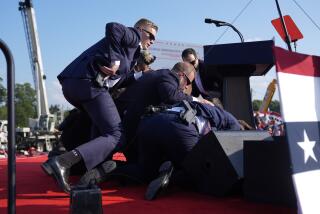Happy 200, White House! : Past Staffers Share Memories of Workplace That’s Like No Other
- Share via
On Oct. 13, during the final, frenzied weeks of the 1992 presidential election, the White House will celebrate its 200th birthday. Amid the fanfare and rhetoric of the race between George Bush and Bill Clinton, it’s likely that few in Washington will have much time to observe this historic occasion.
Earlier this year, however, beneath a quiet tent near the Washington Monument, a small cadre of former White House employees gathered to share their experiences during the Smithsonian’s 1992 Festival of American Folklife. They weren’t power brokers, political aides or high-ranking Cabinet members, but doormen, butlers, engineers, plumbers, housekeepers, chefs and others who have helped keep the Executive Mansion running smoothly for nearly two centuries.
“Their memories span almost a century, through 15 presidential administrations--from William Taft to George Bush,” said Marjorie Hunt, a folklorist who specializes in studying occupational culture at the Smithsonian’s Center for Folklife Programs and Cultural Studies. Hunt organized the festival’s White House workers program.
During the last year, Hunt tracked down former White House workers and conducted oral-history interviews with many of them. Some had worked in the White House for more than 30 years, serving as many as 10 first families. Together, these workers provided a look at the White House that has long been eclipsed by the comings and goings of Presidents and the events of world history.
“The White House is not a hotel; it’s not a private home; it’s not a museum,” Alfredo Saenz, a White House butler, said. “But, on the other hand, it’s all of those things together.”
“When you first go to work at the White House, you are all eyeballs,” said Russell Free, a night engineer who served in administrations from Richard M. Nixon to Ronald Reagan. “Honestly, for the first month, your eyes are as big as teacups. You’re actually drinking in history and current events.”
Free was in charge of controlling the air temperature in the White House, and he vividly remembers former President Nixon’s love of wood fires. On Aug. 8, 1974, the day Nixon relinquished his presidency, “It was 96 degrees in Washington. We had 700 tons of air-conditioning turned on and three fireplaces burning.”
When pianist Vladimir Horowitz came to play at the White House during the Jimmy Carter Administration, Horowitz wasn’t happy with the acoustics of the East Room, Free recalls. The White House staff was called upon to haul carpets from other rooms and arrange them on the floor until Horowitz was satisfied with the sound. While rolling up a large carpet in an upstairs room, Free was bumped by someone doing the same. “It was President Carter,” he said.
Former butler Armstead Barnett recalled his difficulty commuting to work. “When I’d get in a cab and say, ‘Take me to the White House,’ they’d say, ‘To the White House--at this time of night?’ They thought I was telling a story. And they’d sit there and wait till I walked through the gate.”
Barnett, 80, who lived at the White House for four years during Franklin D. Roosevelt’s Administration, ran into problems when he wanted to get married. He listed 1600 Pennsylvania Ave. as his address on the marriage application. Eleanor Roosevelt had to confirm that, indeed, Barnett did live in the White House.
All of the workers--from the doorman to the chef--talked about long hours and dedication to their jobs. “If at 2 o’clock in the morning something breaks down, you fix it right then and there,” Free said. “You don’t wait for parts.”
Once, when a water problem at the White House kept former plumber Howard (Reds) Arrington away from his wife and children for two solid weeks, “Mrs. Eisenhower sent my wife a bottle of perfume and a card,” he recalled.
“There are 37 full bathrooms in the White House, not including the ones for tourists,” he continued. “I was a real White House plumber, not a Watergate plumber.”
According to 92-year-old Alonzo Fields, who worked at the White House for 21 years, first as a butler then as head maitre d’, dedication and professionalism came naturally in the presence of the President. “I didn’t feel like a servant to a man. I felt I was a servant to my government, to my country. I always told the dining room help that worked for me, ‘Remember, we are helping to make history. We have a small part, perhaps a menial part, but they can’t do much here without us.’ ”
Preparing for the receptions, dinners, guests and special events at the White House is an extremely demanding job. Nonetheless, Fields was at the top of his profession, and he relished it. “When I was directing a dinner,” he recalled, “I’d seat the President and step back, and then give a nod to the men to start the service. From then on, I was directing an orchestra. And people would watch, and they’d marvel at it, they really did.”
Fields, who now lives in Boston, served under Presidents Herbert Hoover, Roosevelt, Truman and Dwight D. Eisenhower. He was friends with them all and knew their families on a first-name basis. “I witnessed firsthand the greatest events in history. I looked over the shoulder of the President as America recovered from the Depression, during the bombing of Pearl Harbor and the dropping of the nuclear bomb on Japan. I welcomed the king and queen of England, Winston Churchill, President de Gaulle of France and many other foreign dignitaries.”
During his tenure at the White House, Fields became aware of the plight of the presidency. “It is a thankless job,” he said. “ ‘We the people’ can be a contrary lot, enough to try the soul of any man.”
In his job, Fields daily showed a patriotism and dedication to his country and its leader matched by few of his fellow Americans. Yet as an African-American, he and many of his colleagues were subjected to the humiliation of racism, even within the walls of the White House.
When Fields first went to work at the White House during the Hoover presidency, there were separate dining rooms for black and white staff. “We all worked together, but we couldn’t eat together. Here in the White House, I was working for the President. This is the home of the democracy of the world and I’m good enough to handle the President’s food . . . but I could not eat with some of the help.”
Low pay was also a common problem for White House staff. Barnett recalled a two-week paycheck of $42.50 when he first started as a butler under Franklin Roosevelt. Working at the Executive Mansion was prestigious, he said, “but that’s all it was, too. There sure wasn’t no money in it.”
Today a household staff of 96 full-time employees works to operate, maintain and preserve the 132-room Executive Mansion.
While First Families are only temporary residents, the household staff members are permanent employees, the Smithsonian’s Hunt explained. “For these workers, the transition from one Administration to the next is a difficult and challenging time. On Inauguration Day, they must say farewell to a family they have served for years and begin adjusting to new ways of doing and acting, new likes and dislikes.”
“We took care of the family,” former maitre d’ Eugene Allen said. “We were the first people to see them in the morning and the last at night, many a day.”
“Each family affected me deeply,” former doorman Preston Bruce said. “In my heart, they became my family, my charges.”
“Their kids were just like my kids, almost,” former butler John Johnson told Hunt. “They’d come into the pantry and the kitchen. We used to have little parties for them, and we’d play. And you become very close.”
More to Read
Get the L.A. Times Politics newsletter
Deeply reported insights into legislation, politics and policy from Sacramento, Washington and beyond. In your inbox three times per week.
You may occasionally receive promotional content from the Los Angeles Times.










